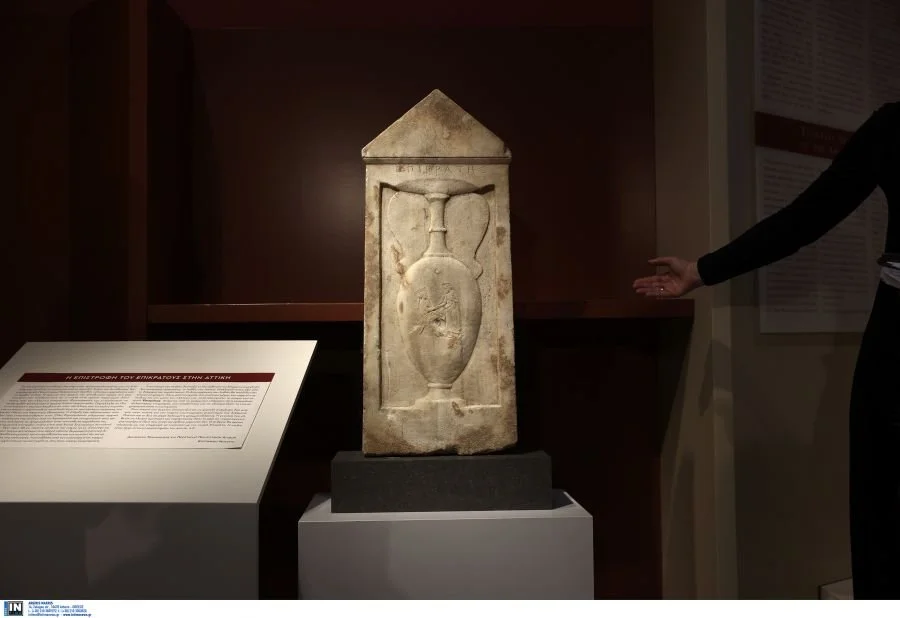The pedimented tombstone, work of an Attic workshop of the 4th c. BC, it is made of white fine-grained Pentelian marble.
At the Epigraphic Museum was presented nine days ago by the Greek Minister of Culture and Sports, Lina Mendoni, a tombstone, which had been identified in an auction list in the United Kingdom and was repatriated.
As the Minister of Culture and Sports Lina Mendoni said, "The Ministry of Culture, especially in recent years, attaches great importance to the repatriation of any cultural asset that is inextricably linked to our homeland. This is a policy which the Archaeological Service follows consistently and systematically, with a commitment to the repatriation of antiquities, which has yielded very important results.
There is no universal rule to be followed for all repatriation cases. Each case of return and repatriation of cultural property is separate and dealt with ad hoc. Every ancient work of art, which is illegally located outside the Greek Territory, must be examined with the relevant data available to the Service. In this particular case of the stele, the documentary material was there and the stele was returned exactly one year. Other claims often do not have a happy ending, precisely because there are not the necessary elements that document the origin and the illegal act per se. Each case requires a separate treatment. I want to thank the Directorate of Documentation and Protection of Cultural Property for its contribution to all repatriations without exception and I wish that next year we will have even more returns of cultural property and successes for the Ministry and its Services".
As stated by the head of the Directorate of Documentation and Protection of Cultural Properties Vasso Papageorgiou, "The marble inscribed tombstone of the 4th c. BC, which ends in a simple triangular pediment, had been identified in the Christie's online auction catalog, scheduled for December 8, 2021. During the control of this particular auction by the competent Department of the DTPPA, it was identified by an archaeologist of the Department, the column was classified as suspicious. After a check, it was found that the tombstone of the auction was a product of illegal trafficking from the Greek Territory, as it is identical to an object that appears in three photographs directly connected to antiquarian activity, from a confiscated photographic file (Bekina file) that is in the possession of the Service from in 2006. However, the most important element, decisive for its assertion with claims, was the fact that the inscribed tombstone is included in the list of movable monuments for which, based on the 2017 Decision of the Fourth Five-Member Court of Appeal of Athens, which became irrevocable in 2020, the antiquities dealer G.B. has been declared guilty because he illegally appropriated them".
Following many months of discussions between the representatives of the Auction House, who were also designated as representatives of the alleged owners, and the Greek side represented by the Police Association of the Greek Embassy in London, Mrs. Elizabeth Toufa, and with the assistance of the Art and Antiques Unit of the Metropolitan Police and of course the instructions of the YPPOA through the DTPPA, the owners of the column agreed to hand it over to the Greek State voluntarily.
The pedimented tombstone, the work of an Attic workshop of the 4th c. BC, it is made of white fine-grained Pentelian marble. It is 88 cm high, 37-35 cm wide and 10 cm thick. It is crowned by a free triangular pediment that once bore a painted floral decoration. A horizontal written band also demarcated the rule of the pediment at the base of the epitaph. The transition from the crown to the body of the column is achieved with an Ionic wave, which was also painted.
On its body, a relief bath-amphora dominates within a rectangular partition, the handles of which are completed outside the partition of the representation. The details of the handles would also be rendered in color. Above the vase, in the upper part of the body of the column and in the middle of its width, the name of the deceased is engraved: Epikratis. Between the letters there are traces of letters of an older inscription, which was scraped off to facilitate the reuse of the monument.
On the belly of the vessel two figures are depicted in low relief in the gesture of reception typical of funerary iconography. They both step on a shallowly carved ground line. The woman seated in a reclining position to the left of the scene shakes hands with a young barren robed man standing in front of her. The man should, according to the inscription, be identified with the dead Epikratis.












